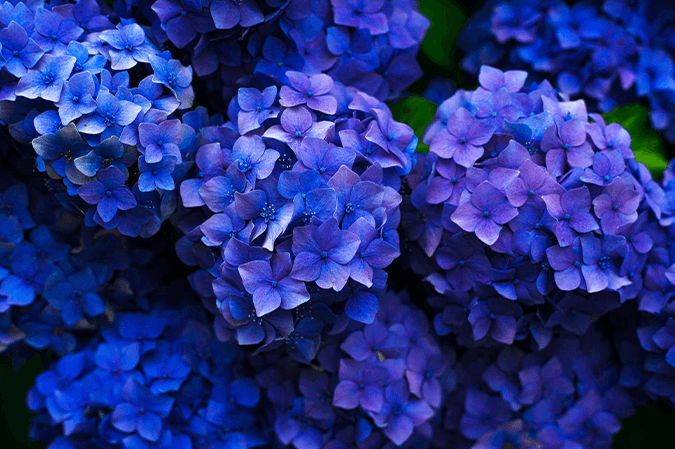Hydrangea is a genus of flowering plants that includes about 75 species. Native to Asia and the Americas, Hydrangeas are beloved for their large, showy flower heads, which come in various colors such as white, blue, pink, and purple. They are popular ornamental plants, often found in gardens and landscapes worldwide.
Description
- Appearance: Hydrangeas are typically shrubs, though some species can grow as small trees or climbing vines. They range in size from about 3 feet to over 10 feet tall, depending on the species and growing conditions.
- Leaves: The leaves of Hydrangeas are usually large, oval-shaped, and have serrated edges. They are typically a deep green color, though they can turn red or purple in the fall.
- Flowers: The flowers of Hydrangeas are arranged in large, round clusters known as corymbs or panicles. The flowers themselves can be small and fertile or large and sterile, often with a mix of both on the same plant. The color of the flowers can vary based on soil pH; acidic soils typically produce blue flowers, while alkaline soils produce pink flowers.
- Roots: Hydrangeas have fibrous root systems that spread widely but are relatively shallow.
Common Features
- Flower Color Variation: One of the most distinctive features of Hydrangeas is their ability to change flower color based on soil pH. This characteristic is most common in species like Hydrangea macrophylla (Bigleaf Hydrangea).
- Long Blooming Season: Hydrangeas typically bloom from late spring to early autumn, providing a long season of interest in the garden.
- Deciduous Nature: Most Hydrangeas are deciduous, meaning they lose their leaves in the fall and remain bare through the winter.
Role in the Ecosystem
- Pollinator Attraction: Hydrangeas attract a variety of pollinators, including bees, butterflies, and other insects. The fertile flowers in the clusters provide nectar and pollen, supporting these important species.
- Habitat: The dense foliage and structure of Hydrangeas provide shelter and nesting sites for small animals and birds. The plants can also offer protection for ground-dwelling creatures.
- Soil Health: Hydrangeas can help prevent soil erosion due to their fibrous root systems, which bind the soil and keep it in place, especially on slopes or in areas prone to runoff.
Importance
- Ornamental Value: Hydrangeas are highly valued in gardens and landscaping for their large, colorful flowers and long blooming season. They are commonly used in borders, hedges, and as focal points in garden designs.
- Cultural Significance: Hydrangeas have various symbolic meanings in different cultures. In Japan, they are associated with gratitude and apology, while in some Western cultures, they symbolize vanity or boastfulness due to their showy nature.
- Cut Flowers and Floral Arrangements: Hydrangeas are popular in floral arrangements and as cut flowers due to their large, eye-catching blooms. They can be used fresh or dried for long-lasting decorations.
- Environmental Indicator: Because Hydrangeas can change color based on soil pH, they can be used as a natural indicator of soil acidity or alkalinity, providing gardeners with insights into their soil conditions.
Interesting Facts
- Color-Changing Abilities: The ability of Hydrangea flowers to change color based on soil pH is a unique trait. This is primarily due to the availability of aluminum ions in the soil, which are absorbed by the plant and influence the pigmentation.
- Ancient Origins: Fossil evidence suggests that Hydrangeas have existed for millions of years, with ancient species found in North America and Asia.
- Toxicity: While beautiful, Hydrangeas contain glycoside compounds, which can be toxic if ingested by humans or pets, causing symptoms like nausea, vomiting, and diarrhea.
- Variety of Species: The genus Hydrangea includes a wide variety of species, each with its own unique characteristics. Popular species include Hydrangea macrophylla (Bigleaf Hydrangea), Hydrangea paniculata (Panicle Hydrangea), and Hydrangea quercifolia (Oakleaf Hydrangea).
- Dried Hydrangeas: Hydrangea flowers can be dried and preserved, retaining their color and shape, making them popular for dried floral arrangements.
Sources
- Royal Horticultural Society – Hydrangea Plant Information
- Missouri Botanical Garden – Hydrangea Overview
- American Hydrangea Society – Hydrangea Information
- Gardener’s Path – Growing and Caring for Hydrangeas



